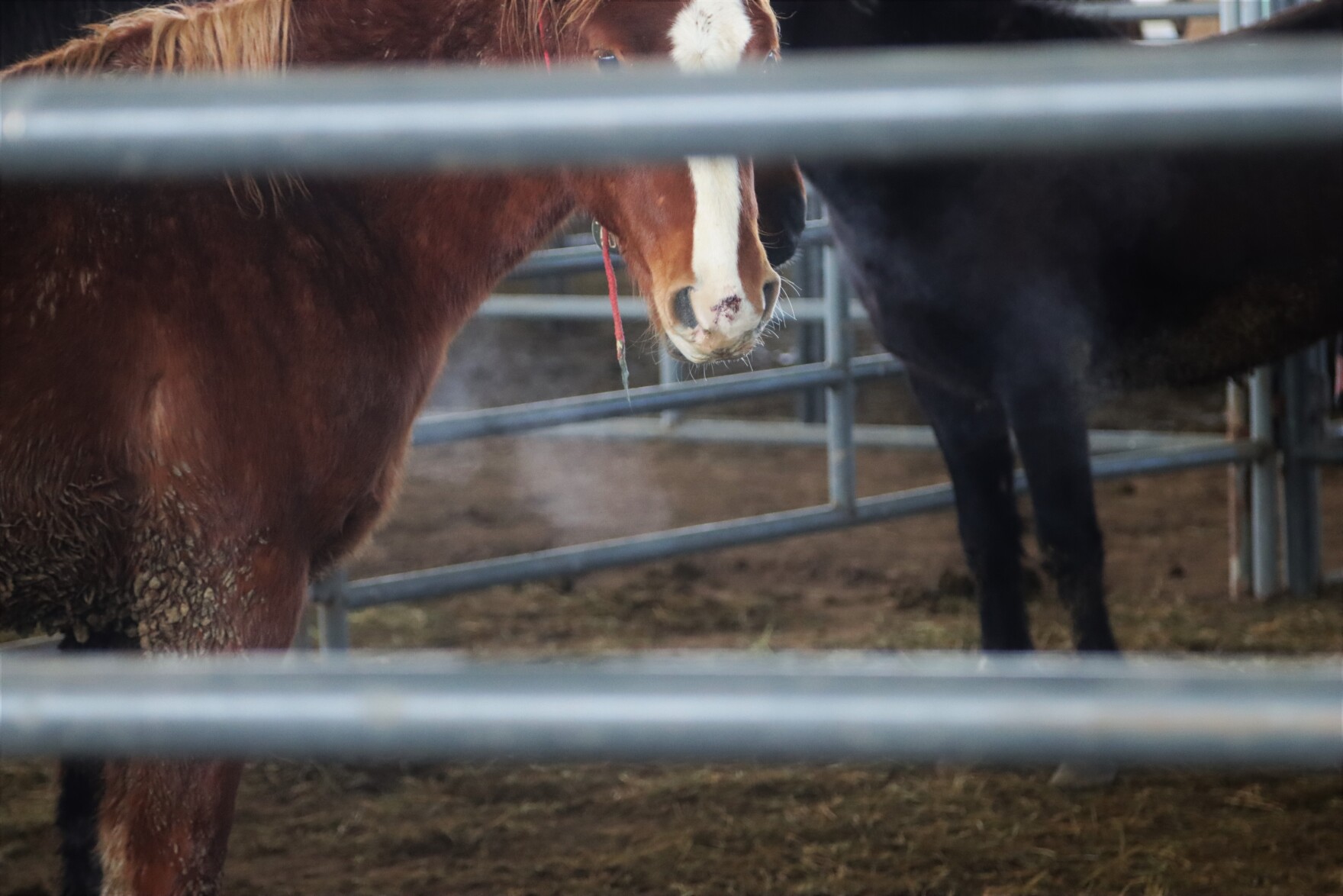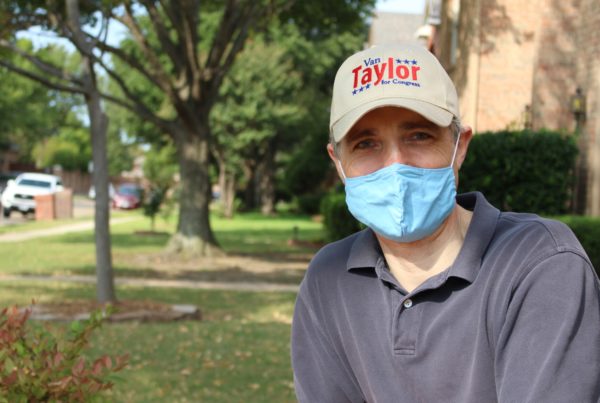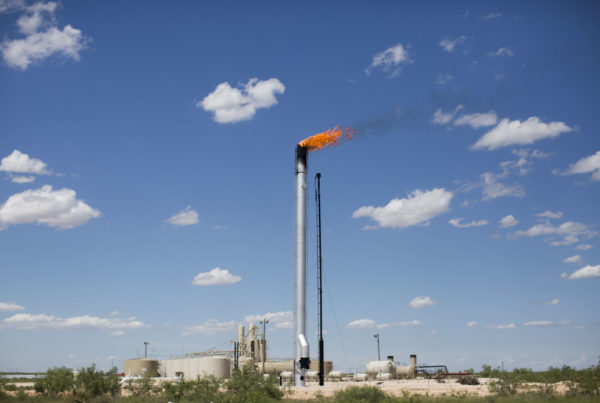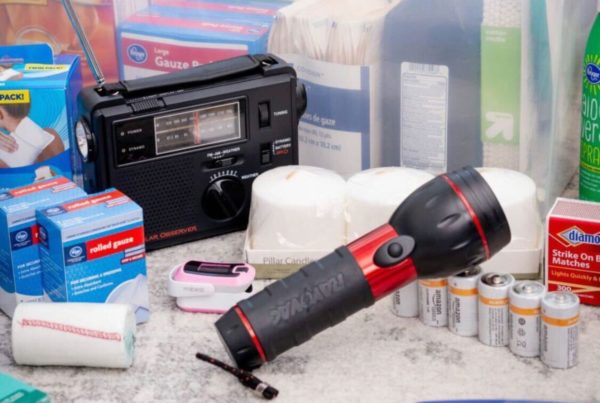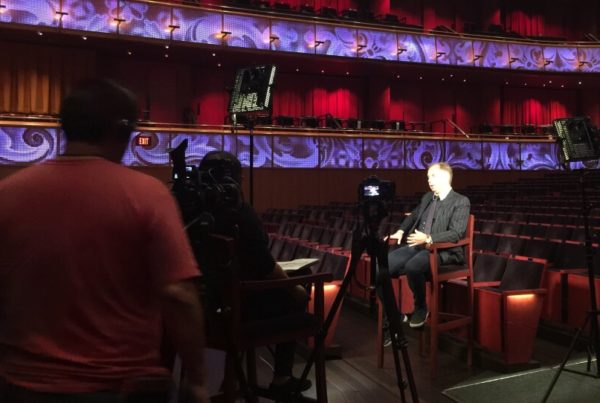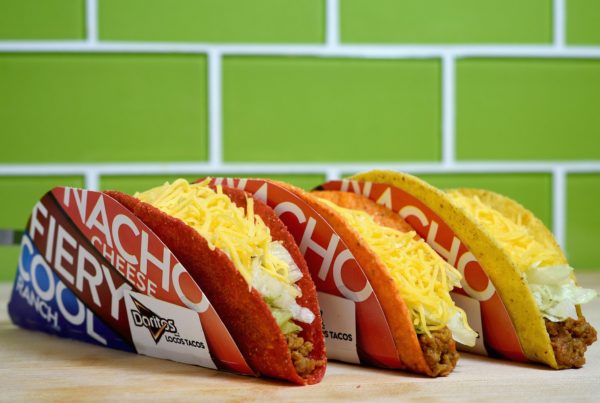One hundred and twenty wild horses and burros were up for adoption from the U.S. Bureau of Land Management last weekend.
A metal and wood door slammed shut behind a dark brown mustang, confining it in a narrow loading chute. Surrounded by a high steel fence on all sides, the wild horse’s hind legs visibly trembled with fear.
Hot breaths of steam shot from his nose.
This horse was adopted. He waited to be loaded into a trailer on a freezing Texas morning.
He wasn’t happy about it. He threw kicks, grunts and then…himself.
The animal raised up on his hind legs and threw his body into the front gate in a desperate attempt at getting his front legs over the gate and possible freedom.
“I hate to see the fear in them,” said Darla Cherry, one of a couple dozen who turned up ahead of the official opening just to walk the pens of wild horses and burros.
More than eight pens were filled with donkeys and varying ages of wild horses. Most were docile that early morning. Some huddled together for warmth and others skirmished for whatever dominance a penned animal can hope for.
“That’s a nice little bay right there,” Cherry said to her daughter Jessica. “He’s a chunky little monkey.”
Cherry owns Meadow Haven Horse Rescue in nearby Smiley, Texas.
Wild horses and burros have been protected from slaughter by law and managed on federal lands across western states for more than 50 years. When that 1971 law passed extolling the feral animals as “living symbols of the historic and pioneer spirit,” population was around 17,000 in the U.S. Now that number is well over 100,000 between federal lands, long-term federal feeding pens and Native American reservations.
The federal government is increasingly relying on adoptions like this one to reduce those numbers.
Nearly everyone agrees those numbers are too large to be sustainable, but that is about all they do agree on. Though removals and adoptions are being ramped up, their effectiveness and federal managers ability to combat fraud are in question.

Cherry attended the adoption to give this reporter her own criticisms of the program, but now her adult daughter may adopt a friendly Roan with dried mud clinging to its legs and belly.
“Is that the one?” she asked her daughter pointing to the brown and white animal. “It came to her; it wants to be involved.”
Most of these animals have never been domesticated and are terrified of humans. This one’s interest is a good sign that it would take training, according to Cherry, whose organization primarily serves neglected and abandoned horses.
“This one is also younger than those…those ones have fought for their lives for a while,” she said.
People adopt not understanding what they are taking on. Cherry has known people who take these wild horses and think they are getting something they can use right away.

They don’t know the months worth of work in front of them, several hours a day. She has seen people take them on thinking they will enter them in the Extreme Mustang Makeover.
“From Wild to Mild” in 100 days boasts the competition from the Mustang Heritage Foundation.
But on the day of the competition?
“They can’t even get them in the trailer,” she says, and these are experienced trainers.
For some of the people at this adoption — pulling wagons with a child in it — this is likely far above their ability.
“I can’t stress enough how dangerous these animals can be,” she said.
Incapable, inexperienced and sometimes outright bad owners let horses escape or sometimes dump them. Sheriff’s departments end up dealing with them. She’s had 14 of these BLM branded horses dropped off the past 10 years.
They have distinct federal brands down the left side of their necks that can tell you where they came from and approximately how old they are.
Her daughter didn’t end up adopting that day, but Cherry still wound up with a BLM-branded horse.
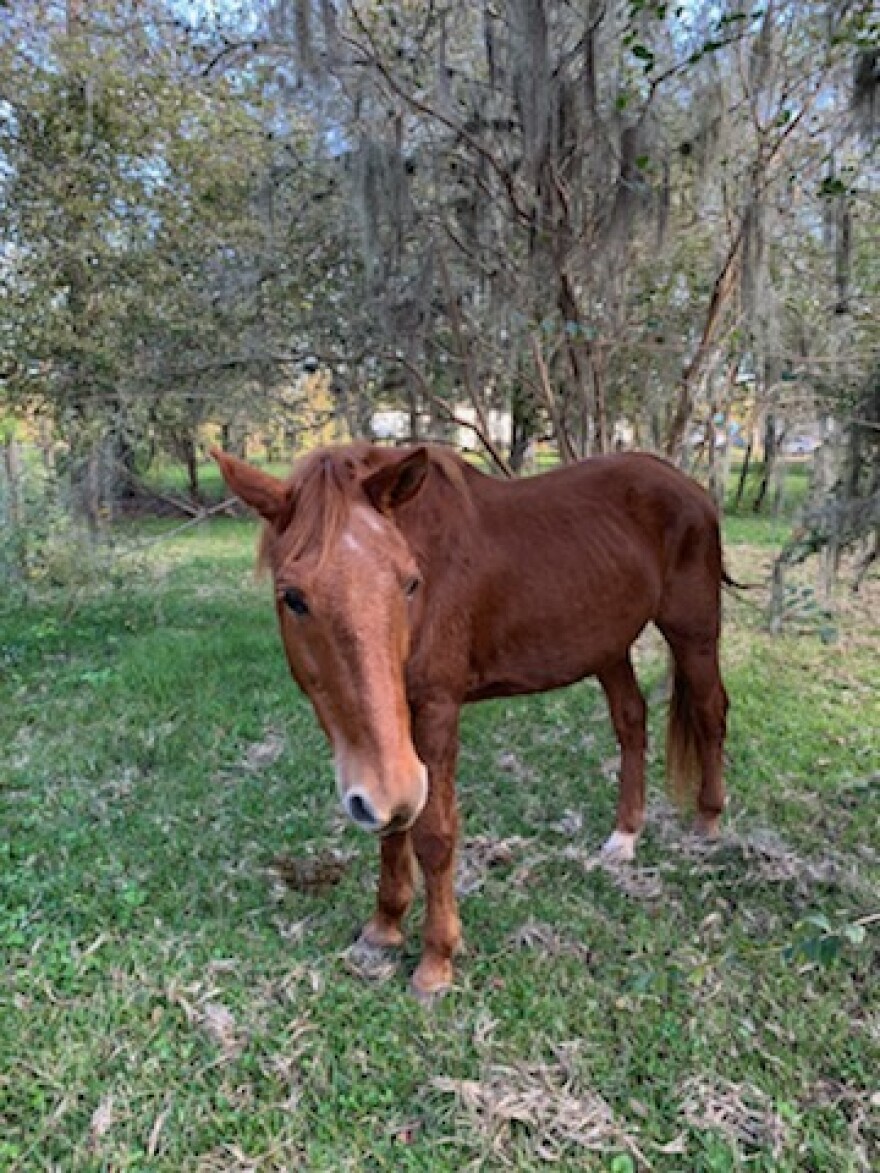
One jumped the fence at Kandi Doherty’s house near Rosharon and decided to stay.
“When I got him, he was bones. You could see his ribs. You could see his backbone. He was horrible.”
She said the 20-year-old horse was dumped in a nearby pasture four years ago before finding her yard last July. She called the county but no one reported it missing.
So now she has been spending $200 a month caring for it. It has eaten all her grass and — while she is terrified of horses — her two kids love it.
But her yard is only an acre which is a tight fit for the family and the horse.
“The horse has on multiple occasions walked underneath the trampoline, and has had the trampoline stuck on him. And we’ve had to go out there with a scared wild mustang and help get the trampoline off the horse,” she said.
She called Cherry to take it off her hands.
But neglect is just one of the issues that wild horse advocates have with the program.
The BLM hit a record of more than 8,000 adoptions last year — the most in 24 years — and is currently planning another record — rounding up and removing more than 19,000 wild horses from federal lands in 2022.
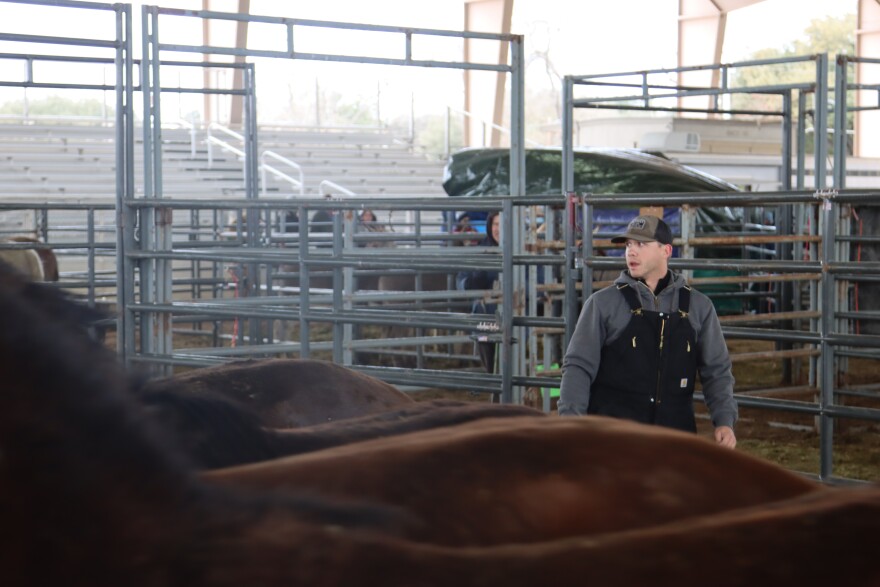
Round-ups use helicopters and cowboys to drive wild horses into pens. It isn’t uncommon for the fearful animals to hurt themselves or even to break their necks.
The federal land managers are ramping up catches to keep up with herd sizes and now with a cash incentive, many more are adopting. The recent record numbers by offering a cash payout starting in 2018 to people who successfully care for the animals for a year.
“We actually pay them $1,000 to care for the animal,” said Evelyn Rodriguez, a member of BLM’s Wild Horse and Burro program present at the Seguin adoption.
“When the incentive program came through, that is kind of when the program picked up really well. And we’ve been going to a lot of the adoptions especially throughout, you know, Texas, Oklahoma and Kansas. And we’ve been doing pretty good,” she said.
Others see another reason for the success.
“Texas, Oklahoma, Kansas are kind of ground zero for the essentially the defrauding of this program,” said Suzanne Roy, executive director of the American Wild Horse Campaign.
“What this program has done is attracted adopters with nefarious intent who are collecting the incentive payments and then flipping the horses to slaughter auctions. And Texas is a very big epicenter of the problem.”
The New York Times wrote about this so-called “horse laundering” last year, showing specific times people sold BLM horses after a year. In one instance a rancher convinced multiple family members to adopt horses (you can only adopt four per household) and after a year sold them to slaughterhouses pocketing tens of thousands of dollars while violating promises made to BLM.
Adopters sign contracts saying they won’t sell to slaughterhouses. But it isn’t clear that any violations have ever been prosecuted.

Healthy horses and burros are largely protected from slaughter by the Wild Free-Roaming Horses and Burros Act of 1971. The agency has not destroyed healthy animals since 1983, but they are charged by law with destroying unhealthy animals in “the most humane manner possible.” And the idea of reopening the conversation of slaughter is not unheard of.
“In the past, destruction of healthy animals also has been discussed to achieve savings,” reads a Congressional Research Service bulletin on the program.
Roy’s organization tries to track when these horses do end up at slaughter auctions. Roy said since last year they found 500 federally branded horses since they started looking in — so far a quarter of them were previously adopted through this program.
“Last year, rescue groups came to us and said, we are seeing a real influx of wild horses and burros in these kill pens. And the timing is directly related to this adoption incentive program,” Roy said.
The BLM introduced new protections in December 2021 including additional inspections, but advocates say they aren’t enough. And Rodriguez said those inspections only occur in that first 12 months. After that the adopter owns the animal.
There’s an estimated 86,000 on public lands, nearly 60,000 in long-term federal holding pens and tens of thousands more on native reservations. Many research papers have shown the size of the herds are negatively impacting the western ecologies. Numbers of sage grouse and other animals have declined and horses are the suspects.

These wild horse numbers are more than triple the 26,000 federal estimates for what is safe on western lands. These have often been disputed by horse advocates as too restrictive — prioritizing commercial cattle which als feed on public lands. This is a charge BLM has denied.
The BLM is spending half its more than $100 million budget just to feed horses in off-range pens.
And the west is increasingly hotter and drier.
In 2018 a herd of horses on Navajo lands died at a watering hole that had dried up. Dr. Tolani Francisco works for the forest service and told the popular Meateater podcast they were already in ill health with little to eat or drink.
“Nearly 200 animals getting in there. They’re all competing for that little bit of moisture. They get stuck in the mire and — it was a horrific scene. The pictures I saw — it just — how tragic. How tragic,” she said.
People don’t want to see that happen again, and most see current strategies as untenable, but there is little consensus on how to address the issue going forward. Many don’t even agree about what to call the animals. Wild is a legal term designated by congress.
Some who see the animals as feral invasive species (the horses that are in North America today are formerly domesticated Western Europeans) believe the “Wild” designation is misleading.
Whether that is through round-ups — that wild horse advocates say are counterproductive — or through fertility control programs that have not been scaled.
“Because without investing in fertility control on the range, you’re just removing horses that you could have prevented from being born. And so it just literally makes no sense,” she said.
Fertility control currently costs an estimated $2,500 per mare.
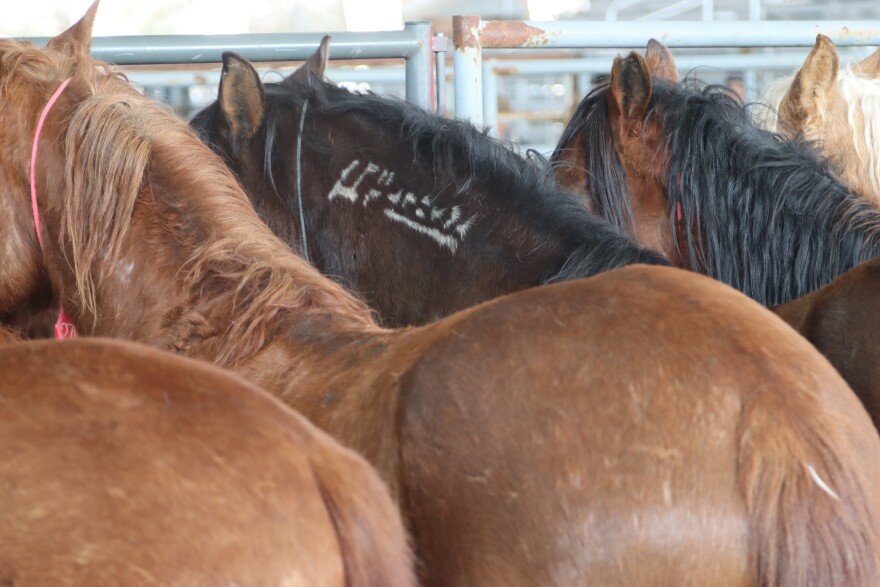
Roy wants the round ups and adoptions stopped. She said more money should go toward anti-fertility programs as well as more land for horses — meaning less public lands for commercial cattle.
Now much of the disagreement revolves around how people see the beasts — as that iconic symbol the west — or as a feral invasive species.


